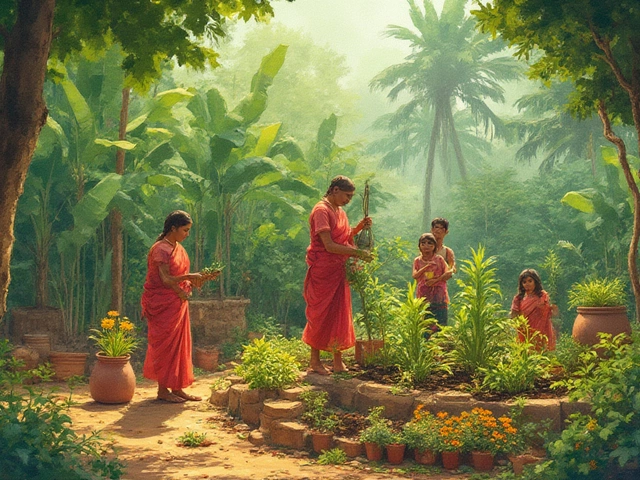Plant Worship in India: What It Is and Why It Matters
If you’ve ever seen a family offering water to a tree or a kitchen corner filled with a fragrant herb, you’ve witnessed plant worship – a practice that blends devotion, health, and nature. Across India, certain plants are treated like family members, believed to bring luck, protect the home, and even improve wellbeing. It’s not a stiff ceremony; it’s a daily habit that anyone can start, no matter the size of your garden.
Why do people worship plants? For many, it’s a way to stay connected to the earth and honor traditions that go back centuries. Ancient scriptures call out plants like Tulsi (holy basil) and Peepal for their divine qualities. When you water them, light a lamp, or chant a simple prayer, you’re not just caring for a plant—you’re participating in a cultural rhythm that many find calming and grounding.
Top Sacred Plants and How to Care for Them
Tulsi (Holy Basil) – The most popular plant in Hindu homes. Keep it in a pot with good drainage, give it morning sunshine, and water when the topsoil feels dry. Offer a few fresh leaves during prayers; the plant thrives on that attention.
Peepal (Ficus religiosa) – Known as the “bodhi tree,” it’s often planted in courtyards. It loves plenty of space, so choose a spot where the roots can spread. Water deeply once a week during dry months, and shade it during extreme heat.
Banana (Musa spp.) – Symbol of fertility and prosperity. A banana plant needs rich, moist soil and regular feeding with compost. Keep the leaf litter around the base; it’s both mulch and a sign of respect.
Neem (Azadirachta indica) – Valued for its medicinal bark and leaves. Plant it in full sun, water moderately, and prune any dead branches. Using neem leaves in cooking or as a natural spray feels like a small offering.
Banyan (Ficus benghalensis) – A massive tree representing longevity. If you have space, a young sapling can become a lasting centerpiece. It likes deep, well‑drained soil and occasional deep watering.
Simple Ways to Incorporate Plant Worship in Your Garden
Start small. Choose one plant that resonates with you; Tulsi is easy for beginners because it tolerates container life. Place the pot where you can see it daily, maybe near the kitchen or prayer area.
Set a daily ritual. It could be as brief as a minute of gratitude, a sprinkle of water, or lighting a small lamp. Consistency matters more than grandeur.
Use sustainable practices. Compost the fallen leaves, reuse rainwater for watering, and avoid chemicals. When you treat the plant kindly, you’re honoring the spirit behind the worship.
Share the habit. Invite family members to join in – children often love the idea of caring for a “holy” plant. Explain the stories behind each species; it turns a simple garden task into a cultural lesson.
Combine worship with practical benefits. Many sacred plants have health perks: Tulsi boosts immunity, neem fights pests, and banana leaves are great for cooking. By caring for them, you’re also improving your own kitchen and home.
Remember, plant worship isn’t about perfection. It’s about building a relationship with nature, respecting traditions, and finding calm in everyday chores. Whether you own a balcony, a tiny terrace, or a sprawling yard, there’s a way to bring this age‑old practice into modern life. Start with one plant, observe how it grows, and let the ritual become a natural part of your day.

Indian God of Vegetables: Myth, Meaning, and Tips for Better Gardening
Is there really a god of vegetables in India? This article uncovers what Indian traditions say about vegetable gods, digs into how myths shape gardening habits, and gives you practical advice to grow better veggies at home. Discover how old beliefs, local customs, and gardening wisdom mix in India’s backyards. Get helpful tips to make your own vegetable patch more abundant. Find answers, quirky tales, and hands-on guidance for gardeners across India.
About
Vegetable Gardening
Latest Posts


Why Do Rice Farmers Flood Their Fields?
By Alden Thorne Mar 4, 2025

Permaculture Gardening: What It Means and How to Get Started
By Alden Thorne May 7, 2025

Which Flower Is Most Grown in India? The Top Cultivated Bloom and Why It Dominates
By Alden Thorne Oct 30, 2025
